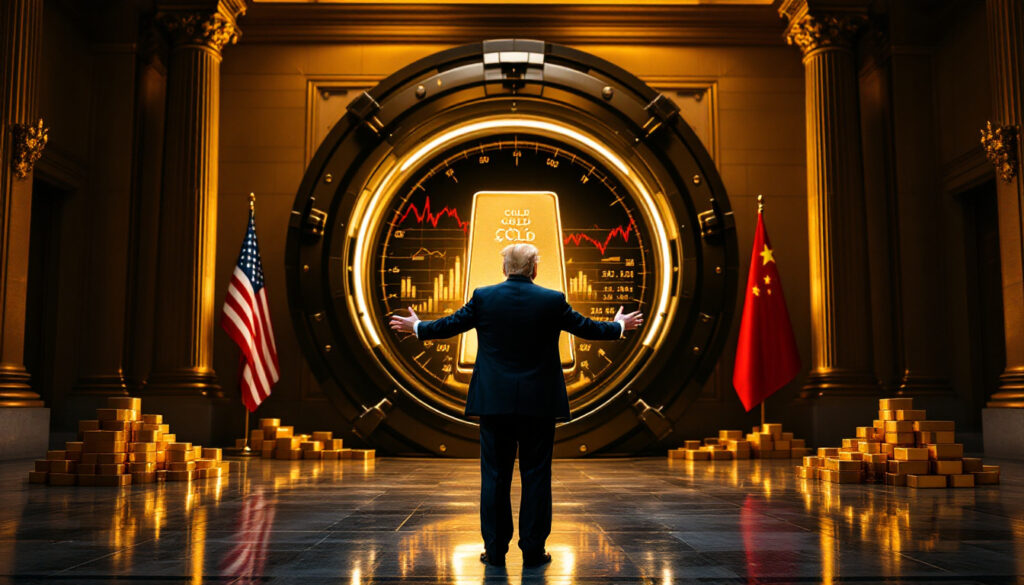Gold as a Safe Haven During Trade Wars: Understanding the Impact on Global Markets
In times of economic uncertainty, gold has consistently proven its value as a financial refuge. The recent escalation of global trade wars has once again highlighted gold's unique position as a safe-haven asset. Between October 2023 and March 2025, gold prices surged an impressive 71.6% during its monster upleg, significantly outperforming the S&P 500's 23.3% gain in 2024. This performance gap becomes even more pronounced during periods of acute trade tension, with gold losing only 0.9% while the S&P 500 plummeted 10.5% over two days following recent tariff announcements.
Gold's remarkable stability during this 17.9-month upleg, experiencing a maximum pullback of just 4.6%, demonstrates why investors consistently turn to this precious metal when geopolitical tensions rise and economic uncertainty looms.
What Makes Gold a Trade War Refuge?
Historical Performance During Economic Uncertainty
Gold has consistently outperformed during periods of economic instability. The current monster upleg shows gold's remarkable 71.6% increase over 17.9 months, demonstrating exceptional resilience compared to other asset classes. This performance isn't unusual – during the 2008 financial crisis, gold as a hedge rose 5.5% while global equities collapsed, a pattern repeated in 2020 with a 25% gain.
When recent trade war tensions escalated in April 2025, gold lost only 0.9% while the S&P 500 fell a dramatic 3.8% over five trading days. This immediate divergence expanded further as the market digested the implications of new tariffs, with equities eventually dropping 10.5% over two days.
For the year 2024, gold delivered 27.2% gains compared to the S&P 500's 23.3%, highlighting its strength even during periods of relative market stability before the latest trade tensions emerged.
Gold's Unique Properties as a Safe-Haven Asset
"Gold's historical outperformance during crises stems from its lack of counterparty risk," notes economist Adam Hamilton. Unlike government bonds or currencies, gold doesn't rely on any entity's promise or obligation, making it immune to default risks that plague other assets during economic turmoil.
Gold's limited supply represents another crucial advantage. While central banks can print unlimited fiat currency, gold's supply grows by only about 1.5% annually through mining production. This scarcity becomes increasingly valuable when trade wars threaten currency stability and inflation risks rise.
Gold's inverse correlation with equities (-0.6 since 2000) and low volatility (12% versus the S&P's 18%) further enhance its hedging utility during market turbulence. This mathematical relationship explains why portfolios containing gold typically experience less overall volatility.
As a universally recognized store of value across different cultures and economic systems, gold maintains its appeal regardless of which countries are engaged in trade disputes. This universal recognition dates back thousands of years, predating modern financial systems.
How Are Trade Wars Affecting Gold Prices?
Recent Market Movements and Price Trends
Gold reached $3,123 on March 31, 2025, before Trump's "Liberation Day" announcement of reciprocal tariffs, which initially caused some volatility in the precious metals market. However, gold quickly demonstrated its safe-haven status by rebounding 3.8% in a single day as the implications of the trade war escalated.
Gold prices subsequently soared above $3,200 as investors increasingly sought refuge from market turbulence. Despite the monster upleg spanning almost 18 months, gold has experienced only a 4.6% pullback at worst, remaining well below the 10% correction threshold that would typically define a market correction.
The rapid recovery from even minor setbacks highlights the strong underlying demand for gold during periods of economic uncertainty, particularly when that uncertainty stems from trade disputes that threaten global growth and stability.
Technical Analysis of Gold's Current Position
Gold was extremely overbought at 18.1% above its 200-day moving average on March 31, 2025, a technical condition that often precedes a pullback. The subsequent consolidation reduced this to 11.8%, effectively relieving overbought conditions without triggering a significant correction.
RSI levels dropped from 82 (overbought) to 58 post-pullback, relieving selling pressure while maintaining the underlying bullish trend. This technical reset provides room for the next phase of growth as trade tensions continue to support safe-haven demand.
Remarkably, gold has avoided any 10%+ corrections during the entire 17.9-month upleg, demonstrating unprecedented resilience. This lack of significant pullbacks is extremely rare in commodity bull markets and speaks to the strength of underlying demand.
Gold futures positioning shows room for further growth with speculative longs at only 67% of their trading range. This indicates substantial potential for additional buying pressure as more speculators enter the market, potentially driving prices toward $3,400 by Q3 2025.
Who Is Driving Gold Demand During Trade Wars?
Central Bank Purchasing Patterns
Central banks have been leading gold's monster upleg through consistent purchasing, with global institutions buying a record 1,136 metric tons in 2024. This unprecedented level of buying reflects growing concerns about the dollar's reserve currency status in an increasingly fractured global economy.
China's central bank holds only about 5% of its $3,241 billion foreign reserves in gold, far below the global average of 15%. As stated by PBOC Governor Yi Gang, "Diversification from USD reserves is accelerating," indicating significant room for continued Chinese gold accumulation.
Global central banks are accelerating diversification away from US dollars as trade tensions rise, with BRICS nations being particularly aggressive buyers. This represents a structural shift in reserve management that could support gold price drivers for years to come.
Central banks view gold as insurance against geopolitical risks, including trade wars, which explains their willingness to continue buying even as prices rise to historic levels. Unlike private investors who may be price-sensitive, central banks typically take a multi-decade view of their gold holdings.
Investor Behavior Across Different Markets
American investors have barely started participating in gold's upleg, representing a significant potential catalyst for future price appreciation. GLD+IAU holdings (the two largest gold ETFs) have only increased 6.3% (80.3 metric tons) during the current 71.6% gold upleg, showing minimal retail investor participation compared to previous bull markets.
Chinese investors are likely to increase gold purchases as the trade war impacts their stock market, creating additional demand from the world's largest gold consumer. Cultural affinity for gold in China becomes even more pronounced during periods of economic uncertainty.
American stock investors' gold allocation remains extremely low at approximately 0.27% of portfolios, far below the 5-10% recommended by financial experts during periods of economic uncertainty. This represents over $1 trillion in potential capital that could flow into gold if allocations move toward recommended levels.
The virtuous circle dynamic of higher prices attracting more investors, who drive prices higher and attract even more investors, has not yet materialized in this gold bull market. When this psychology takes hold, as it did in previous cycles, price appreciation could accelerate dramatically.
What Are the Economic Implications of Trade War Tariffs?
Impact on Global Supply Chains
Trump imposed baseline 10% tariffs for all countries with higher rates for specific nations, creating widespread disruption across global supply chains built over decades of globalization. Companies face difficult decisions about whether to absorb costs, raise prices, or restructure operations.
China faces potential 125% tariffs (though implementation has a 90-day pause), threatening to devastate trade relationships built over decades. Vietnam, a major manufacturing competitor to China that has benefited from previous trade tensions, now faces 46% tariffs, eliminating many of its cost advantages.
Companies like Apple, importing 90% of products from China, face significant supply chain disruption and margin pressure. Apple's Q4 2024 China revenue represented 14.9% of its total, highlighting both supply chain and market exposure to China-U.S. tensions.
Ford Motor Co. faced a 12% profit drop in Q1 2025 due to steel tariffs, exemplifying how input cost increases can rapidly erode profitability even for domestic manufacturers. The ripple effects extend far beyond companies directly importing finished goods.
Effects on Corporate Earnings and Stock Markets
The S&P 500 collapsed 10.5% over two days following tariff announcements, reflecting investor concerns about the fundamental impact on corporate profitability. Companies with international exposure face a double threat from input cost increases and potential retaliatory tariffs on their exports.
About 40% of S&P 500 companies' revenues come from outside the US, creating significant vulnerability to trade disruptions and retaliatory measures from trading partners. This overseas exposure, once seen as a diversification benefit, now represents a material risk.
Retaliatory tariffs will force higher selling prices, reducing demand and eroding profits across multiple sectors. Consumer-facing businesses may face particularly difficult challenges as they balance price increases against potential volume losses.
Higher tariffs threaten to burst the AI stock bubble that has dominated market attention, as semiconductor and technology hardware companies face both supply chain disruptions and potential demand destruction from economic slowing. This sector rotation could further benefit gold trade war refuge as investors seek alternatives.
How Do Gold Stocks Perform During Trade Wars?
Gold Mining Companies' Performance Metrics
Gold miners show impressive earnings growth with the GDX-top-25 stocks reporting year-over-year profit increases of 87%, 47%, 35%, 84%, 74%, and 78% in the last six quarters. This consistent earnings growth stands in stark contrast to the broader market, where earnings growth has been much more modest.
Q1 2025 is tracking for approximately 100% year-over-year earnings growth, potentially the best in all stock markets. As gold prices have risen while operating costs have remained relatively stable, mining companies are experiencing significant operating leverage.
Despite gold's 71.6% upleg, the VanEck Gold Miners ETF (GDX) has only rallied 77.4%, suggesting significant upside potential based on historical performance patterns. Typically, major gold stocks amplify gold gains by 2x to 3x, implying that mining stocks are substantially undervalued relative to the metal.
Barrick Gold's P/E ratio of 18x versus the industry average of 25x highlights the valuation opportunity in the sector. Many gold mining companies are trading at historically low multiples despite record profitability.
Investment Opportunities in Gold Mining Sector
Gold stocks remain deeply undervalued despite consecutive quarters of profit growth, creating compelling opportunities for investors seeking leverage to gold prices. The disconnect between operational performance and stock prices is particularly pronounced in mid-tier producers.
Previous monster gold uplegs saw GDX average 105.4% gains (2.5x leverage to gold), suggesting the current upleg should theoretically push GDX 143% to 215% higher based on historical patterns. This provides a quantitative framework for estimating potential upside.
Recent market fear created buying opportunities in fundamentally strong gold mining stocks, particularly those with low production costs and significant exploration upside. Companies operating in stable jurisdictions with strong balance sheets offer the best risk-adjusted return potential.
The combination of rising gold prices and relatively stable input costs creates a sweet spot for mining company profitability. Unlike previous cycles where cost inflation quickly eroded margin gains, the current environment features more disciplined capital allocation and cost control.
What's Next for Gold in the Trade War Environment?
Short-Term Price Projections
Gold's technical position after the pullback creates favorable conditions for continued upward movement. With gold currently 11.8% above its 200-day moving average, there's substantial room for appreciation before reaching extremely overbought levels again.
Reduced overbought conditions provide room for growth toward $3,400 by Q3 2025, representing approximately 6% upside from current levels. This target is derived from both technical factors and fundamental drivers including central bank buying and safe-haven demand.
Futures positioning indicates potential for additional buying pressure as speculative positioning remains well below previous peaks. When combined with the psychological impact of round-number price targets, this creates the potential for accelerated moves as $3,300 and $3,400 come into view.
Recent price action demonstrates gold's resilience during market volatility, suggesting that even if equity markets stabilize, gold is unlikely to surrender recent gains. This asymmetric risk profile makes gold particularly attractive in the current environment.
Long-Term Investment Considerations
A virtuous circle dynamic could develop as higher prices attract more investors, particularly if mainstream financial media begins to highlight gold's outperformance. Increased retail participation typically marks the middle to late stages of gold bull markets.
Experts recommend 5-10% gold allocation in investment portfolios, yet current allocations remain far below these levels. The gap between recommended and actual allocations represents over $1 trillion in potential capital flows into the gold market.
Gold miners offer leveraged exposure to rising gold prices with the additional benefit of dividend income. Several major producers have implemented dividend policies tied directly to gold prices, creating yield opportunities not available from bullion.
Continued central bank buying provides strong fundamental support for higher prices, particularly as China and other BRICS nations seek to reduce dollar dependence. Demand from aging populations and renewable energy technology (including solar panels) further strengthens the 2025 gold outlook and beyond.
FAQs About Gold During Trade Wars
How does gold typically perform during trade wars?
Gold typically outperforms most other assets during trade wars as investors seek safe-haven investments amid economic uncertainty. The current gold market analysis shows gold lost only 0.9% while the S&P 500 fell 3.8% during the first five days of the recent trade war escalation, demonstrating its relative stability.
What percentage of portfolio should be allocated to gold during economic uncertainty?
Financial experts typically recommend a 5-10% allocation to gold in investment portfolios, especially during periods of economic uncertainty like trade wars. Current data shows American stock investors have only about 0.27% of their portfolios allocated to gold, suggesting significant room for increased investment.
Are gold mining stocks better investments than physical gold during trade wars?
Gold mining stocks offer leveraged exposure to gold price movements, historically amplifying gold gains by 2-3x. During the last two monster gold uplegs in 2020, the GDX gold miners index delivered average gains of 105.4%, representing 2.5x leverage to gold's performance. However, mining stocks come with additional operational and company-specific risks.
How do central bank gold purchases affect gold prices during trade wars?
Central bank gold purchases provide significant support for gold prices, especially during trade wars when these institutions seek to diversify away from US dollar reserves. With China holding only about 5% of its $3,241 billion foreign reserves in gold, there is substantial potential for increased central bank buying as trade tensions escalate.
"Our country and its taxpayers have been ripped off for more than 50 years." – Donald Trump, explaining his rationale for implementing reciprocal tariffs
Investors seeking to capitalize on gold's status as a trade war refuge might also consider Gold ETFs strategies as an alternative to physical bullion, providing exposure to the metal with greater liquidity and lower storage concerns.
According to a recent Reuters report, "Gold prices climbed as investors sought safe-haven assets amid escalating trade tensions between major economies," confirming the precious metal's continued role as a financial refuge during periods of geopolitical uncertainty.
Are You Ready to Identify the Next Major Mineral Discovery?
Stay ahead of the market with Discovery Alert's proprietary Discovery IQ model, which instantly notifies investors of significant ASX mineral discoveries and transforms complex mineral data into actionable insights. Visit the Discovery Alert discoveries page to understand how major mineral discoveries have historically generated substantial returns for early investors.




